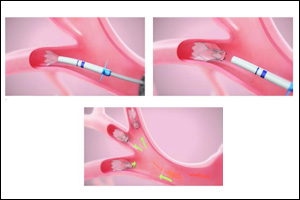- Home
- Editorial
- News
- Practice Guidelines
- Anesthesiology Guidelines
- Cancer Guidelines
- Cardiac Sciences Guidelines
- Critical Care Guidelines
- Dentistry Guidelines
- Dermatology Guidelines
- Diabetes and Endo Guidelines
- Diagnostics Guidelines
- ENT Guidelines
- Featured Practice Guidelines
- Gastroenterology Guidelines
- Geriatrics Guidelines
- Medicine Guidelines
- Nephrology Guidelines
- Neurosciences Guidelines
- Obs and Gynae Guidelines
- Ophthalmology Guidelines
- Orthopaedics Guidelines
- Paediatrics Guidelines
- Psychiatry Guidelines
- Pulmonology Guidelines
- Radiology Guidelines
- Surgery Guidelines
- Urology Guidelines
Endobronchial valve cost-effective option to medical management :2018 NICE COPD Guidelines

An endobronchial valve is a cost-effective option to medical management, recommends 2018 NICE COPD Guidelines.
National Institute for Health and Care Excellence (NICE) in the UK has released it's 2018 guidance on the diagnosis and management of COPD. It expanded to include which patients should be referred for evaluation for bronchoscopic lung volume reduction with Endobronchial Valves. The Endobronchial Valves offer a minimally-invasive treatment option that improves quality of life of emphysema patients by allowing them to breathe easier, be less short of breath, and be more active.
Bronchoscopic lung volume reduction with the Endobronchial Valve is a one-time procedure performed through a bronchoscope; it requires no cutting or incisions. During the procedure, an average of four tiny valves are placed in the airways to block off the diseased parts of the lungs. This allows trapped air to escape until the lobe is reduced in size resulting in patients being able to breathe easier.
Key highlights in the NICE Report include:
- "Strong" recommendation to assess patients with severe COPD for suitability for lung volume reduction procedures, including the use of Zephyr Endobronchial Valves based on an in-depth analysis of patient outcomes data including improved lung function, quality of life, exercise capacity and survival.
- "The criteria for referring patients for lung volume reduction assessment has been broadened because treatment options now include endobronchial valves, a less invasive option which may benefit patients who were not candidates for more invasive surgical treatments. The broadening of criteria will lead to more referrals and improved access to treatment for patients."
- Emphysema patients who have completed pulmonary rehabilitation, stopped smoking, have lung function of less than 50% of predicted, can walk at least 140 meters in 6 minutes (a standard exercise test), and suffer from breathlessness should be referred for evaluation for lung volume reduction procedures.
"NICE is respected globally for their in-depth evidence reviews and systematic approach to clinical guideline development. We appreciate NICE's thorough review of clinical data from multiple published Zephyr Valve randomized clinical trials 1, and believe this guidance will be a valuable resource for providers and payers seeking to improve patient care" said Glen French, President and Chief Executive Officer of Pulmonx.
The guideline committee further concluded that the endobronchial valve is likely to be cost-effective compared with medical management.
"Patients with COPD suffer from breathlessness and that results in poor mobility and a lower quality of life. These patients need new, less invasive options and I am very pleased to see NICE recognize this need and recommend lung volume reduction with the Zephyr Valves," said Professor Pallav Shah of the Royal Brompton Hospital, London. "We hope to see other physicians refer more COPD patients to pulmonary specialists be evaluated for this less-invasive option."

The Zephyr Valve was approved by the FDA in June 2018, through an expedited review because it "represents a breakthrough technology as the device offers bronchoscopic lung volume reduction without surgery and its associated risks. This results in patients being able to breathe easier and have less shortness of breath.
Chronic obstructive pulmonary disease (COPD) is a progressive, life-threatening lung disease that includes emphysema and chronic bronchitis. More than 65 million people suffer from COPD globally and it is estimated that 3.2 million deaths were caused by the disease in 2015 (5% of all deaths globally).

Disclaimer: This site is primarily intended for healthcare professionals. Any content/information on this website does not replace the advice of medical and/or health professionals and should not be construed as medical/diagnostic advice/endorsement or prescription. Use of this site is subject to our terms of use, privacy policy, advertisement policy. © 2020 Minerva Medical Treatment Pvt Ltd